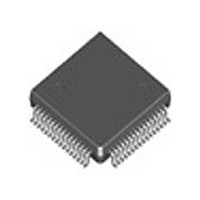IDT77105L25TF IDT, Integrated Device Technology Inc, IDT77105L25TF Datasheet - Page 7

IDT77105L25TF
Manufacturer Part Number
IDT77105L25TF
Description
Manufacturer
IDT, Integrated Device Technology Inc
Datasheet
1.IDT77105L25TF.pdf
(24 pages)
Specifications of IDT77105L25TF
Data Rate
25.6Mbps
Number Of Channels
1
Type Of Atm Phy Interface
UTOPIA
Operating Supply Voltage (typ)
5V
Operating Supply Voltage (min)
4.5V
Operating Supply Voltage (max)
5.5V
Operating Temp Range
0C to 70C
Operating Temperature Classification
Commercial
Pin Count
64
Mounting
Surface Mount
Lead Free Status / RoHS Status
Not Compliant
Available stocks
Company
Part Number
Manufacturer
Quantity
Price
Company:
Part Number:
IDT77105L25TF
Manufacturer:
IDT
Quantity:
825
Part Number:
IDT77105L25TF
Manufacturer:
IDT
Quantity:
20 000
Company:
Part Number:
IDT77105L25TFI
Manufacturer:
IDT
Quantity:
853
against the 4 high order bits (X(t), X(t-1), X(t-2), X(t-3)) of a 10 bit
pseudo-random nibble generator (PRNG). Its function is to provide the
appropriate frequency distribution for the signal across the line.
whether the processed nibble is part of a data or command byte. Note
however that only data nibbles are scrambled. The entire command byte
(X _C) is NOT scrambled before it's encoded (see diagram for illustra-
tion). The PRNG is based upon the following polynomial:
generated from the following equations:
X(t+1).
time an X_X command is sent. An X_X command is initiated only at the
beginning of a cell transfer after the PRNG has cycled through all of its
states (210 - 1 = 1023 states). The first valid ATM data cell transmitted
after power on will also be accompanied with an X_X command byte.
Each time an X_X command byte is sent, the first nibble after the last
escape (X) nibble is XOR'd with 1111b (PRNG = 3FFx).
possibility of a reset PRNG start-of-cell command and a timing marker
command occurring consecutively does exist (e.g. X_X_X_8). In this
case, the detection of the last two consecutive escape (X) nibbles will
cause the PRNG to reset to its initial 3FFx state. Therefore, the PRNG is
clocked only after the first nibble of the second consecutive escape pair.
nibbles are further encoded using a 4b/5b process. The 4b/5b scheme
ensures that an appropriate number of signal transitions occur on the
line. A total of 17 5-bit symbols are used to represent the 16 4-bit data
nibbles and the one escape (X) nibble. The table below lists the 4-bit
data with their corresponding 5-bit symbols:
IDT77105
The 'Scrambler' takes each nibble of data and exclusive-ORs them
The PRNG is clocked every time a nibble is processed, regardless of
X
With this polynomial, the four output data bits (D3, D2, D1, D0) will be
D3 = d3 xor X(t-3)
D2 = d2 xor X(t-2)
D1 = d1 xor X(t-1)
D0 = d0 xor X(t)
The following nibble is scrambled with X(t+4), X(t+3), X(t+2), and
A scrambler lock between the transmitter and receiver occurs each
Because a timing marker command (X_8) may occur at any time, the
Once the data nibbles have been scrambled using the PRNG, the
10
+ X
ESC(X) = 00010
7
+ 1
0010
0110
1010
1110
Data
0000
0100
1000
1100
Data
Symbol
Symbol
01010
01110
11010
11110
10101
00111
10010
10111
0001
0101
1001
1101
Data
0011
0111
1011
1111
Data
Symbol
01001
01101
11001
11101
Symbol
01011
01111
11011
11111
3445 drw 03a
.
.
7 of 24
erties. Among them is the fact that the output symbol bits can be repre-
sented by a set of relatively simple logic equations. The other main
advantage is that it contains transmission properties that are desirable,
which include:
whether a timing marker command (X_8) or a start-of-cell command was
sent (X_X or X_4). If a start-of-cell command is detected, the next 53
bytes received are decoded and forwarded to the descrambler. (See
Receive Block Diagram, Figure 2).
encoder. The NRZI code transitions the wire voltage each time a '1' bit is
sent. This, together with the previous encoding schemes guarantees
that long run lengths of either '0' or '1's are prevented. Each symbol is
shifted out with its most significant bit sent first.
continuing to transmit valid symbols. It does not, however, transmit
another start-of-cell command until it has another cell for transmission.
lated automatically across the first 4 bytes of the cell header, depending
upon the setting of bit 5 of register 0x03. This byte is then either inserted
as a replacement of the fifth byte transferred to the PHY by the external
system, or the cell is transmitted as received. A second operating mode
provides for insertion of "Bad" HEC codes which may aid in communica-
tion diagnostics.
before each symbol is reassembled. The symbols are then sent to the
5b/4b decoder, followed by the Command Byte Interpreter, De-Scram-
bler, and finally the UTOPIA interface to the outside world. Note that
although the IDT77105 can detect symbol and HEC errors, it does not
attempt to correct them.
UDF = User Defined Field (or HEC)
This encode/decode implementation has several very desirable prop-
On the receiver, the decoder determines from the received symbols
The output of the 4b/5b encoder provides serial data to the NRZI
When it has no cells to transmit, the 77105 keeps the line active by
Transmit HEC Byte Calculation/Insertion
Byte #5 of each ATM cell, the HEC (Header Error Control) is calcu-
Receiver Description
On the receiving end, the inverse occurs. The data is NRZI decoded
ATM Cell Format
!
!
!
!
Transition averages over 3 per 5 signal elements;
Encode/Decode is not affected by the incorporation of the
scrambler;
Run length is limited to <= 5;
Disparity never exceeds +/- 1.
Bit 7
Header Byte 1
Header Byte 2
Header Byte 3
Header Byte 4
Bit 0
Bit 7
Payload Byte 48
Payload Byte 1
September 11, 2000
UDF
3445 drw 03b
Bit 0
















